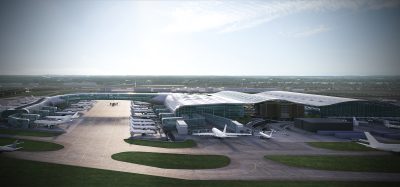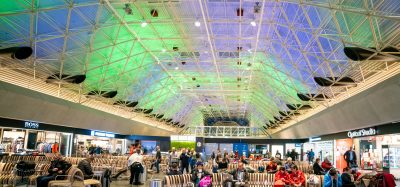Coping in Copenhagen
Posted: 6 June 2012 | Dan Meincke, Director of Traffic and Airside Operations, Copenhagen Airport | No comments yet
The date was 23 December 2010. Copenhagen Airport (CPH) had prepared for the peak travel day of the Christmas season with 70,000 excited passengers ready to pass through its terminals. We were all ready and had successfully managed to handle traffic, despite several weeks of snow. What we did not know was that on that peak day in December, we were about to get 53cm of snow instead of the expected 10cm.
I have never experienced anything like it during the 20 years I have been in charge of Copenhagen Airport’s winter operations. We had snow bombs, as cold air was making the sea around us steam with snow clouds. But the combination of our experience, our extensive preparations and our many highly dedicated employees enabled us to get everybody home for Christmas. It was an incredible day, after a couple of weeks of severe winter weather that had almost closed down all air traffic in northern Europe and the UK. It was expensive for everybody, especially the airlines. Very expensive. What saved Christmas in 2010 for our passengers and airlines was our recent change of snow clearing methods, a change that enabled us to clear our 3.6km-long, and 45m-wide runways in less than 15 minutes.
Although delays occurred, we were able to handle all traffic during the 35 days of snowfall that paralysed air traffic in several other countries that year.
The date was 23 December 2010. Copenhagen Airport (CPH) had prepared for the peak travel day of the Christmas season with 70,000 excited passengers ready to pass through its terminals. We were all ready and had successfully managed to handle traffic, despite several weeks of snow. What we did not know was that on that peak day in December, we were about to get 53cm of snow instead of the expected 10cm.
I have never experienced anything like it during the 20 years I have been in charge of Copenhagen Airport’s winter operations. We had snow bombs, as cold air was making the sea around us steam with snow clouds. But the combination of our experience, our extensive preparations and our many highly dedicated employees enabled us to get everybody home for Christmas. It was an incredible day, after a couple of weeks of severe winter weather that had almost closed down all air traffic in northern Europe and the UK. It was expensive for everybody, especially the airlines. Very expensive. What saved Christmas in 2010 for our passengers and airlines was our recent change of snow clearing methods, a change that enabled us to clear our 3.6km-long, and 45m-wide runways in less than 15 minutes.
Although delays occurred, we were able to handle all traffic during the 35 days of snowfall that paralysed air traffic in several other countries that year.
CPH’s maximum runway capacity is 83 mixed operations (take-offs/landings) per rolling hour with two runways in use. During peak periods, our runway capacity is utilised in full. In November and December 2010 alone, there were 35 days of snowfall, with 50 per cent of the snowfall occurring during peak hours, and we never closed the airport once during the period. Before we adopted our new methods, it took 40-60 minutes to clear a runway of snow. During that period, the runway would be closed to traffic, thereby reducing capacity by 50 per cent. Today, we can clear a runway in 10-15 minutes. This means that we are close to normal operations, even in the case of heavy snowfall.
Co-ordination
The secret is to fight the snow with heavy machinery and highly trained employees in close collaboration with airlines, handling companies, de-icing platforms and Air Traffic Control. One of the important things is to co-ordinate snow clearing and de-icing to avoid bottlenecks.
The work therefore, has to be performed very quickly.We now clear snow using 12 snow clearing vehicles and two snow blowers followed by a sprayer and a car with two electricians who can repair runway lighting that may have been disrupted during the operation. At the end of the convoy is a friction vehicle that checks whether the runway friction figure is above the required 0.40. The IT system of the friction vehicle sends the information on the runway condition directly to the tower in order to keep air traffic controllers and handlers updated at all times.
This intensified effort has naturally come at a cost, but it was not as high as one might have imagined. The reason is that our staff are highly flexible. For example, a bus driver may drive a bus, clear snow, move baggage carts and empty waste bins, all during the same working day. This means that even peak periods can be handled with fewer resources. We have 50 people on call 24/7. In addition to our 80 permanent employees in the department we have 120 volunteers who are on call as volunteer snow fighters during their spare time.
In addition to the traffic manager, there is always a duty snow clearing manager in charge of co-ordinating the teams on the runways, taxiways and apron areas. Contact is co-ordinated with the foremen of the individual teams and also with the de-icing teams and Air Traffic Control.
The process
It is an impressive sight when the 9m-wide yellow sweepers and snow blowers from Øveraasen roll along the runway in a staggered convoy. If just one of the sweepers does not perform correctly, the effect may be that the runway cannot be released for traffic and must be cleared again. Conversely, the runways do not have to be dry as on a sunny summer day. But they must be cleared so as to ensure that friction does not limit operations and that safety is at its highest.
We then clear the other runway and the taxiways. During constant snowfall, we continue this work all day. In brief, it is an operation that requires a lot of planning and precision. We therefore spend a lot of time training our staff during the autumn to ensure that everybody is ready for winter.
Over the years, we have developed a number of training programmes, both for general snow clearing and for handling individual vehicles, ranging from large sweepers and snowblowers to tractors and snow ploughs. All staff, including the managers, have attended an intensive, two-day course at which they have been trained in the new methods. This is in addition to all the practical training in operating the vehicles. We have also provided training for our external business partners. For example, all of the 120 Air Traffic Controllers have attended courses, and meetings have been held with all our customers, not least the airlines and the handlers.
We do this partly by focusing sharply on the costs to the airlines of operating at Copenhagen Airport. A prerequisite for that strategy is that we can provide stable operating conditions, also in case of heavy snowfall.
Being in control
This past winter season of 2011/12, we had only two days of snow but lots of frost. So the challenge was to keep everybody ready and prepared, even during periods with blue skies and no snow. We achieved this by training, and by constantly challenging ourselves, turning it into a competition and trying to beat our own records and performance.
Ultimately, success within winter operations is being able to control something that has yet to happen.
Sensing the snow
In 1999, Copenhagen Airport was one of the first airports in the world to establish an ice warning system using an intelligent computer system to predict ice and freezing rain with much greater precision than before. This means greater reliability and less use of chemicals.
The complex warning system gets weather information from 28 sensors and four weather stations in different locations of the airport area. It enables Copenhagen Airport’s staff to predict with great certainty when and how much of the de-icer, Aviform, to apply to the runways. This means that the warning system increases not only the operational reliability of the airport. The much more precise prediction and prevention activities have reduced our con – sumption of Aviform by 50 per cent.
The mechanics
We may have the world’s best plans and procedures, staff and machinery. But it is all no good, if our equipment breaks down and we have to wait for repairs.
Copenhagen Airport’s repair shop is a very important player in our operations. The mech – anics must always be ready with spare parts and backup so that we can handle the unavoidable. In order not to waste resources at the repair shop and to avoid breakdowns as much as possible, we perform systematic maintenance, ensuring that the repair shop is constantly up-to-date on the state of repair of the individual vehicles, including on their wearing parts, such as brushes.
Winter operations equipment
- 23 Øveraasen Sweepers (model RS400, SB470 and RS200)
- Five Snow Blowers – Schmidt, Øveraasen, Oshkosh and Viking
- 32 tractors – John Deere, Lundberg Hymas and Kubota
- Six anti-icer spreaders – Damman, Epoke and NIDO Stratos
- Two SAAB friction testers
- Clearing runways and taxiways takes 12 sweepers, two blowers, one Damman de-icer and one SAAB friction car
About the author
Since 2009, Dan Meincke has been Director of Traffic and Airside Operations at Copenhagen Airport. Prior to this he was the Executive Advisor on equipment and tech – nology for extreme weather at the airport from 1991-2009. He was the Airside Manager at Copenhagen from 1984-2009 and before this was the airport’s IT specialist from 1980-1984.
Join our free webinar: Beyond silos: How ecosystem thinking elevates the airport experience
In today’s complex aviation landscape, airports are moving beyond siloed operations to embrace a new era of collaboration. This webinar focuses on how leading airports are using ecosystem thinking to adapt, personalize, and continuously improve every touchpoint, boosting both passenger satisfaction and non-aeronautical revenue.
Date: 13 Nov | Time: 10:00 GMT
REGISTER NOW TO SECURE YOUR SPOT
Can’t attend live? No worries – register to receive the recording post-event.

















